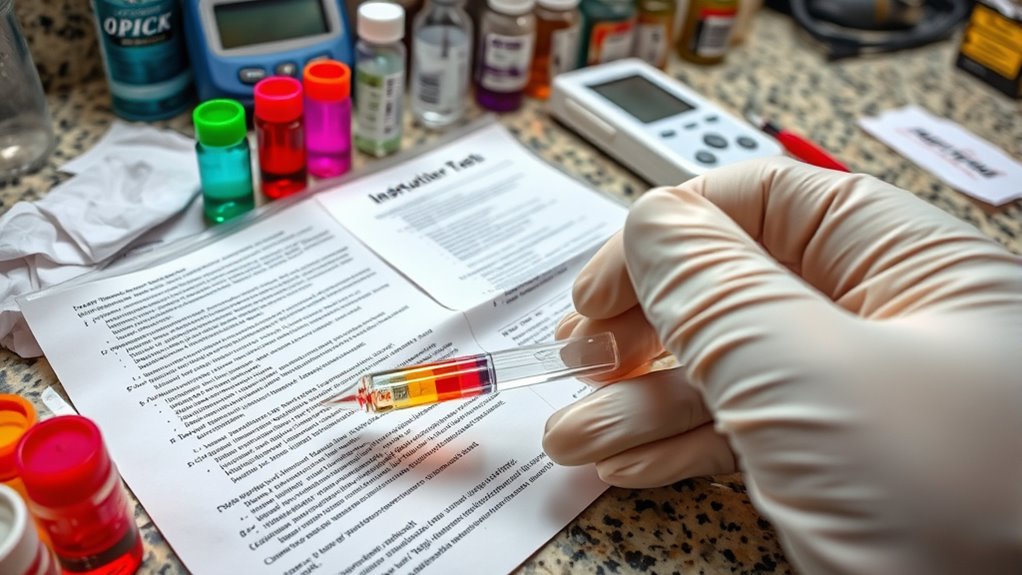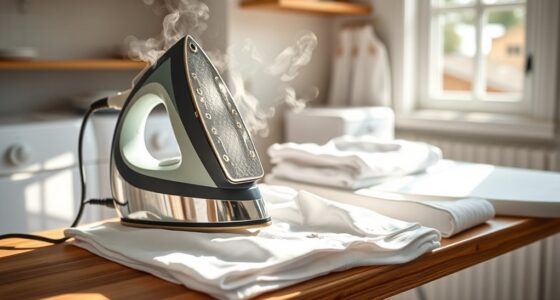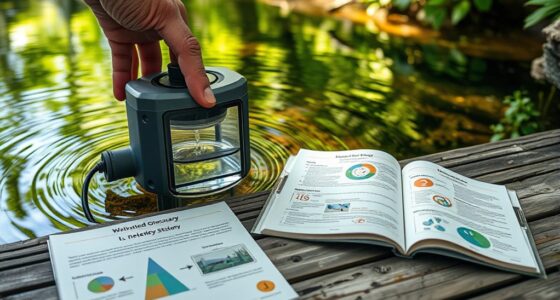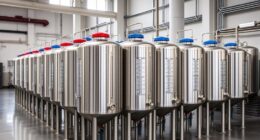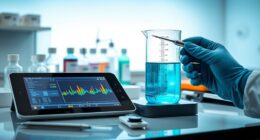Many people assume DIY water testing kits can detect all contaminants, but they only target common pollutants and miss many emerging toxins. Negative results don’t guarantee your water is safe, and not all kits are equally accurate or approved by authorities. These tests seem simple and easy to interpret, yet they often require proper techniques and expertise. They don’t replace professional lab analysis, and cost doesn’t always reflect reliability. If you want to understand the real limitations, keep exploring further.
Key Takeaways
- DIY kits only detect a limited range of common pollutants, missing many contaminants and emerging chemicals.
- Negative results from home tests do not guarantee water safety; false negatives are possible.
- Proper sampling, storage, and handling are crucial; mistakes can significantly skew results.
- DIY kits often lack the accuracy and reliability of professional lab testing, risking misleading conclusions.
- Cost-effective kits may compromise quality and precision, leading to inconsistent or unreliable outcomes.
DIY Kits Can Detect All Water Contaminants

Many people assume that DIY water testing kits can identify every possible contaminant in their water supply. However, these kits have limitations in contaminant detection. They often target only common pollutants, leaving many others undetected. Relying solely on a DIY kit can give you a false sense of security if the test results come back negative. False negatives happen when contaminants are present but the kit fails to identify them, leading you to believe your water is safe when it isn’t. These kits can’t cover the full spectrum of potential pollutants, especially emerging or less common contaminants. Thus, while useful for initial screening, DIY kits shouldn’t replace professional testing for extensive water safety. Always consider additional testing if you suspect contamination. Additionally, DIY water testing kits typically do not include testing for contaminant reduction technologies or the presence of bacteria and viruses that require specialized analysis.
Negative Results Guarantee Safe Water
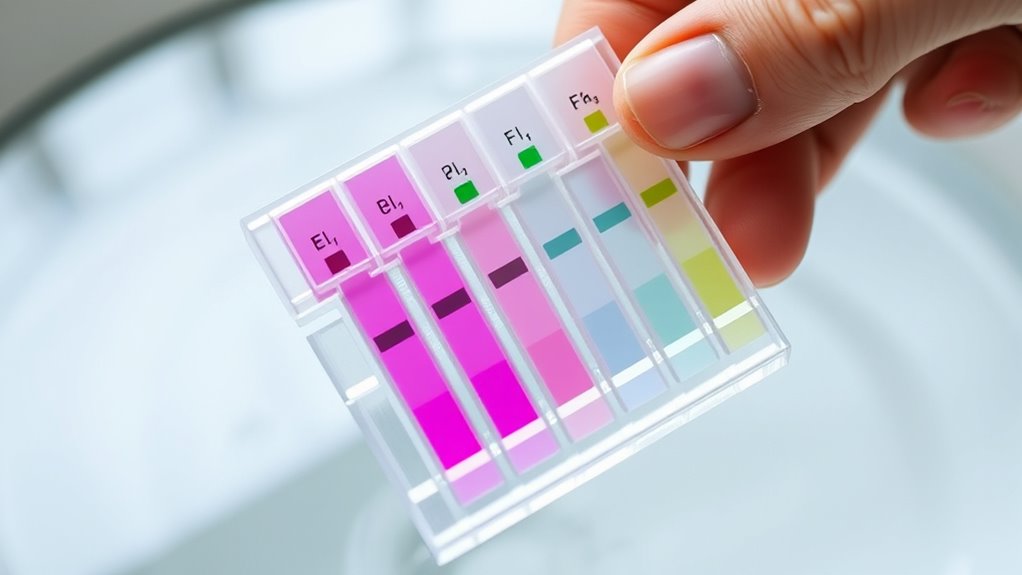
A negative result on a DIY water test doesn’t necessarily mean your water is safe. Test accuracy varies, and contamination detection can be limited by the kit’s sensitivity. Relying solely on a negative result might give false reassurance, as some harmful contaminants might go undetected. It’s essential to understand that no test is perfect. Here’s a quick look at how results relate to water safety:
| Result Type | Implication | Limitations |
|---|---|---|
| Negative | No contaminants detected | Possible false negative |
| Positive | Contamination confirmed | May need lab confirmation |
| Inconclusive | Uncertain, retesting recommended | Test sensitivity issues |
| Safe Water | Water appears safe based on test results | Not a guarantee of safety |
Always consider follow-up testing and professional analysis for all-encompassing safety. Additionally, understanding the limitations of testing kits can help you better interpret the results and decide on necessary actions.
All Testing Kits Are Equally Accurate
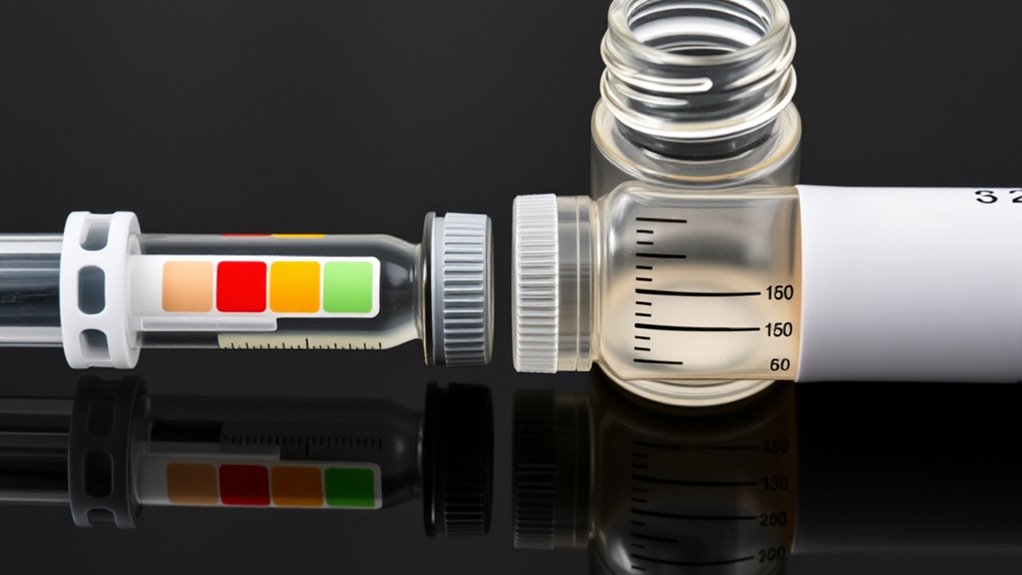
While all DIY water testing kits claim to assess your water quality, they do not offer the same level of accuracy. Laboratory accuracy and regulatory approval are key factors that differentiate reliable kits from less dependable ones. Many low-cost tests lack the precision needed for meaningful results, leading you to false assurances or unnecessary concern. Additionally, data-driven strategies can help you compare and select the most accurate testing kits based on verified performance. Here’s what to consider:
- Laboratory accuracy ensures test results reflect true water quality.
- Regulatory approval indicates the kit meets established safety and efficacy standards.
- Some kits use outdated or less sensitive methods, reducing accuracy.
- High-quality kits often cost more but provide more reliable, actionable data.
Don’t assume all kits are equal—invest in ones validated for accuracy and approval to get trustworthy results.
DIY Tests Are Simple and Require No Expertise
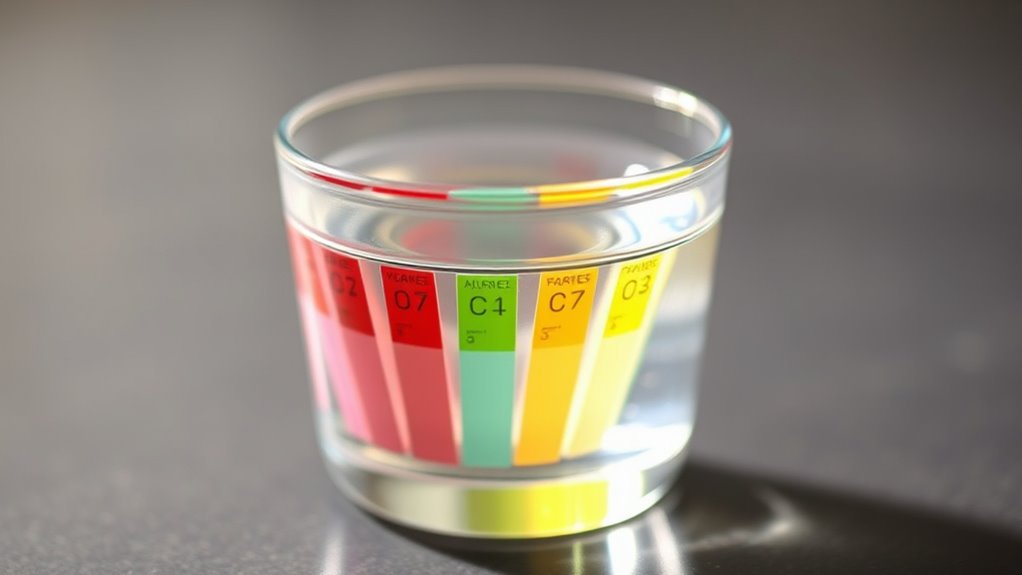
Despite concerns about accuracy, DIY water testing kits are designed to be straightforward and user-friendly, often giving the impression that you can perform them without any specialized knowledge. However, achieving reliable results depends on proper sampling accuracy, which requires careful collection techniques. Many kits rely on reagents that need to remain stable; if reagent stability is compromised—due to improper storage or handling—the test results can be inaccurate. While these kits simplify the testing process, they still demand attention to detail and understanding of basic procedures. Assuming no expertise is needed can lead to mistakes, such as incorrect sampling or reagent misuse, ultimately compromising your data. In reality, some level of testing protocol familiarity is essential to ensure meaningful and accurate water quality results.
Results From Home Kits Are Always Clear and Easy to Interpret
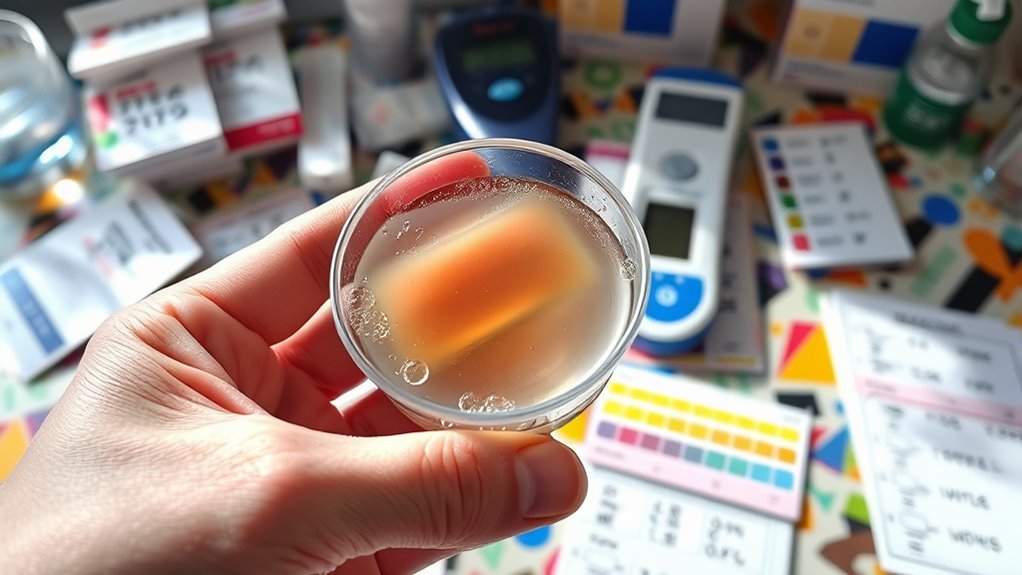
You might assume that home test results are straightforward and easy to understand, but that’s not always the case. Results can vary between tests, and misinterpreting color changes or readings can lead to false conclusions. Inconsistent testing methods further complicate getting clear, reliable results. Additionally, understanding the nutrients and their levels in your water requires proper interpretation of test outcomes, which can be challenging without proper knowledge.
Variability in Results
Results from home water testing kits often vary, making it difficult to rely on a single test for accurate information. This sampling variability can lead to result inconsistency, confusing users about water quality. Factors influencing this include differences in:
- Sample collection methods
- Timing of testing
- Storage conditions
- Test kit sensitivity
These issues mean your results might fluctuate even if your water quality remains unchanged. You could see a sample pass one test and fail another, which complicates decision-making. The inherent variability underscores that home tests aren’t always definitive. Instead, multiple tests or professional lab analysis provide more dependable insights. Recognizing this variability helps you understand that a single DIY water test isn’t a final answer, but part of a broader evaluation process. Understanding industry trends can also help you stay informed about the most reliable testing practices.
Misinterpretation Risks
Home water testing kits often give the impression that results are straightforward and easy to understand. However, this can lead to accuracy misconceptions, where you assume the results are always clear-cut and definitive. In reality, interpreting these results can be tricky, and user misinterpretations are common. You might misread color changes or misjudge contamination levels, leading to false reassurance or unnecessary concern. Without proper training or understanding of the testing process, it’s easy to draw incorrect conclusions. Relying solely on home kit results can create a false sense of security or cause unnecessary panic. To avoid these risks, it’s essential to understand the limitations of your testing kit and seek professional guidance if you’re unsure about what your results truly mean. Additionally, understanding the limitations of testing methods helps ensure accurate interpretation and proper response.
Inconsistent Testing Methods
Many home water testing kits are marketed as simple tools that deliver clear, easy-to-understand results. However, their results can vary due to inconsistent testing methods. Sampling errors often occur when samples aren’t taken correctly, leading to inaccurate readings. Calibration issues can cause tests to produce unreliable results if the kit isn’t properly calibrated or if the calibration drifts over time. These factors make it difficult to trust that results are always consistent or comparable. Additionally, Kia Tuning techniques highlight the importance of precise procedures to achieve optimal performance, which parallels the need for meticulous testing processes in water quality assessment. Be aware of these issues:
- Improper sample collection
- Inconsistent timing during testing
- Variations in reagent quality
- Calibration drift over time
Understanding these pitfalls helps you interpret results cautiously, recognizing that home kits may not always reflect true water quality.
These Kits Replace Professional Laboratory Testing

While DIY water testing kits offer a convenient way to check water quality, they cannot fully replace professional laboratory testing. These kits are prone to sampling errors that can skew results, making them less reliable for definitive analysis. Lab accuracy is typically higher because professional labs use advanced equipment and standardized procedures, reducing the chance of human error. Relying solely on DIY kits might lead you to overlook serious contaminants or misjudge water safety. Laboratory testing provides exhaustive, precise insights that DIY kits can’t match. If you need definitive results for health or regulatory reasons, professional testing remains essential. DIY kits are useful for quick checks and routine monitoring, but they shouldn’t be considered substitutes for lab analysis when accuracy and reliability are critical. Additionally, understanding testing limitations is crucial to interpreting results correctly and ensuring water safety.
The Cost of DIY Kits Reflects Their Reliability

Because DIY water testing kits tend to be inexpensive upfront, their lower cost often suggests they’re a reliable and affordable option. However, the cost accuracy of these kits doesn’t always match their price. Lower prices can lead to compromised reliability, risking inaccurate results. When evaluating affordability, consider that cheaper kits might save money initially but could require multiple tests or professional follow-up, increasing overall costs. Keep in mind:
- Cheap kits may lack precise measurements
- Inconsistent results reduce reliability
- Limited testing parameters affect accuracy
- Long-term costs can outweigh initial savings
- Some kits may use inferior components that impact performance
While affordability is attractive, it’s essential to weigh these factors against the need for accurate, trustworthy data. Remember, the true cost of testing includes both price and the reliability of the results you get.
Only Tap Water Needs Testing
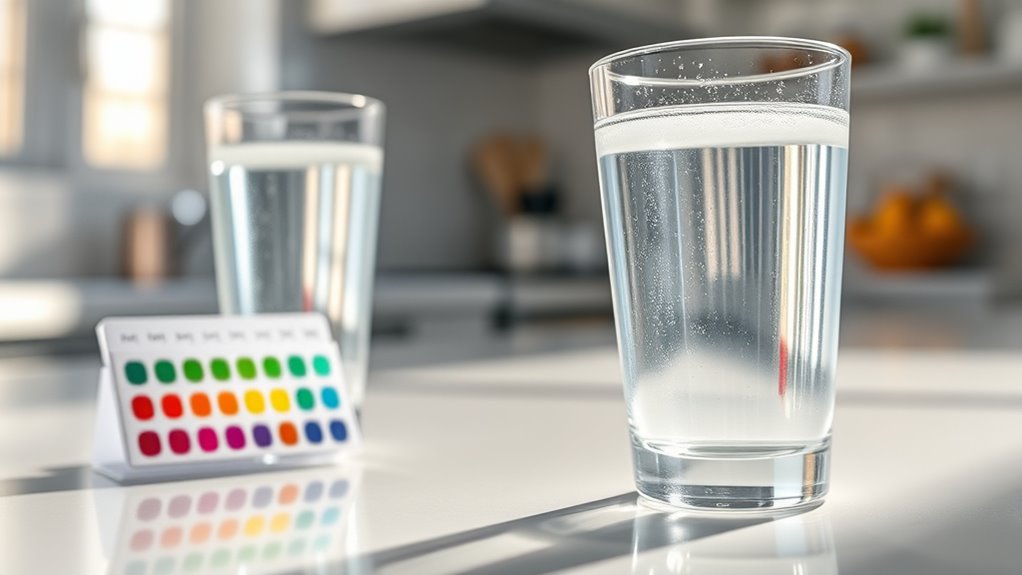
Many people assume only tap water needs testing, but other sources can also have contaminants. Ignoring wells, bottled water, or home filtration systems might leave you unaware of hidden risks. Testing beyond tap water guarantees you’re truly safe in all the water you use.
Limited Scope of Testing
Focusing only on tap water when using DIY testing kits limits your understanding of your overall water quality. These kits have scope limitations that restrict what they can detect, often focusing on a few common contaminants. This narrow contaminant coverage means you might miss pollutants in other water sources or specific issues affecting your household. By relying solely on these tests, you risk false reassurance about your water safety. Remember, water from different sources can contain unique contaminants. To truly understand your water health, consider the following:
- Limited detection of industrial chemicals
- Inability to identify bacteria in non-tap sources
- Overlooking pollutants in well or bottled water
- Missing out on testing for pesticides or heavy metals
Understanding these limitations helps you make better-informed decisions about your water safety.
Ignoring Other Water Sources
While tap water often receives the most attention, other water sources like wells, rainwater collection, and outdoor streams can harbor different or more dangerous contaminants. Many people overlook these sources, assuming they’re safe without testing. Well water, for example, can contain bacteria, nitrates, or heavy metals from nearby land use or natural deposits. Rainwater collection might seem pure but can pick up pollutants from roofs, gutters, or air pollution. Outdoor streams may carry pathogens or industrial chemicals. Relying solely on tap water testing ignores these risks, leaving you vulnerable to health issues. If you use well water, collect rainwater, or frequently access outdoor water sources, you should test them regularly. Failing to do so can lead to exposure to contaminants you might never suspect.
Home Water Systems Matter
Although other water sources can carry unique contaminants, your primary concern should be testing your tap water. Your home’s water system directly affects your health, so ensuring it’s safe is essential. Regular testing helps identify issues caused by aging plumbing or insufficient water filtration. Neglecting plumbing maintenance can lead to mineral buildup or pipe corrosion, impacting water quality. Remember, contaminants are most likely to originate from your tap rather than other sources. To stay safe, focus on:
- Maintaining effective water filtration systems
- Checking for lead or heavy metals
- Ensuring pipes aren’t corroded
- Scheduling routine plumbing maintenance
DIY Water Tests Are Approved by Authorities

Many DIY water testing kits are approved by regulatory agencies, making them a reliable option for evaluating your water quality. Regulatory approval indicates that these kits meet specific standards for accuracy and safety, backed by scientific validation. When a kit has such approval, you can trust that its results are credible and consistent. However, not all DIY kits carry this approval, so it’s essential to check for certification from organizations like the EPA or NSF. Relying on approved kits helps you avoid false negatives or positives, giving you confidence in your water quality assessments. Remember, approval doesn’t replace proper testing procedures, but it does mean your kit has undergone rigorous scientific validation to ensure reliable results.
Frequently Asked Questions
Can DIY Water Testing Kits Detect Bacteria and Viruses?
DIY water testing kits can detect bacteria, but they generally can’t reliably identify viruses. Bacteria detection is more common because kits often include tests for coliforms or E. coli, which indicate contamination. However, virus identification usually requires specialized lab equipment and professional testing. So, while these kits are helpful for initial bacteria screening, you shouldn’t rely solely on them for extensive virus detection. For accurate results, consider professional testing.
How Often Should I Test My Water With DIY Kits?
They say “an ounce of prevention is worth a pound of cure,” so you should test your water regularly. For the best results, testing frequency depends on seasonal variations, water source, and usage. Test at least every 3 to 6 months, and more often during heavy rain or droughts. Staying vigilant helps catch issues early, ensuring your water stays safe year-round.
Are DIY Water Testing Kits Suitable for Well Water?
Yes, DIY water testing kits are suitable for well water. They help you identify potential well water contamination issues, but keep in mind that testing accuracy can vary. Regular testing with reliable kits guarantees you catch contaminants early. While DIY kits are convenient, consider confirming results with a professional lab for critical concerns. This way, you safeguard your health and maintain safe, clean well water.
Do DIY Kits Require Calibration or Special Handling?
Think of DIY water testing kits as delicate instruments needing careful tuning. They generally don’t require extensive calibration, but some may need simple calibration requirements to guarantee accuracy. Handling precautions are vital; always follow the instructions to avoid contamination or damage. Proper handling safeguards the test results and maintains kit integrity, much like a fine instrument. Stay attentive during testing to get reliable, accurate water quality readings.
What Are the Limitations of DIY Water Testing Compared to Lab Tests?
DIY water testing kits have accuracy limitations compared to lab tests, mainly due to less sensitive equipment and simpler methods. You might encounter sample contamination or improper handling, which can skew results. While kits are useful for quick checks, they don’t provide the detailed analysis labs offer. For critical concerns like heavy metals or pathogens, it’s best to rely on professional lab testing to guarantee precise, reliable results.
Conclusion
Don’t assume DIY water testing kits are foolproof or replace professionals. While they seem simple and affordable, false negatives or overlooked contaminants can give you a false sense of security. Imagine trusting a kit only to discover hidden pollutants later—your water’s safety shouldn’t be left to guesswork. For true peace of mind, combine DIY tests with expert lab analysis. After all, when it comes to your health, precision matters more than convenience.
